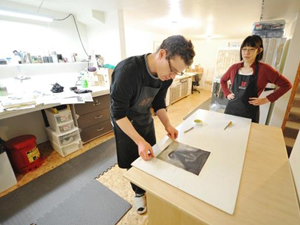
Partners in printmaking, Sean Caulfield and Akiko Taniguchi prepare a newly-inked print in their Edmonton home studio. Photograph by: John Lucas, John Lucas/Edmonton Journal
EDMONTON - It seems like it was destined for Edmonton print artist Sean Caulfield to meet Akiko Taniguchi.
It was at his exhibition in 1999, at the Gallery of the Canadian Embassy in Tokyo, a day after he attended her exhibition opening and was struck by the similarities in their styles.
"Even before we met, I could see we shared a kind of language sensibility, an interest in biological forms and nature, and ideas about cycles," says Caulfield.
"When we show together now, you can tell each other's work apart, but there is definitely a common language, and, as we have worked together over the last 10 years, it is getting closer."
Caulfield travelled to Japan several times for work and for pleasure after his first encounter with Taniguchi. The following year, the couple was sharing Taniguchi's minuscule 350-sq.-ft. Tokyo apartment, along with a printing press.
Their life was, "sleep, eat, print," Taniguchi says.
They married in 2001 and the printmaking continued in their Edmonton home.
Though palatial by Japanese standards, their basement studio - 8.5 metres by 3.4 metres - is actually quite humble and is necessarily laid out for efficiency and function. At one end of the studio sits the large printing press shipped from Japan and a table to ink and wipe plates. Rows of shelves are used to store materials and house their library.
At the other end is a plain chest, which is lined with drawers to curate and store prints. A long desk faces the wall where the two artists sit to draw, side-by-side. A portable table is within reach for when Caulfield works on his five-foot tall woodcuts. He grins, pointing to the puncture holes in the low ceiling.
An assortment of mysterious tools are laid out - hake brushes, rollers, burnishers, something called a mezzotint rocker - all used for various printmaking processes, including chine collé, intaglio, etching, mezzotint and woodcut.
The laundry room doubles as an etching studio, where acid is applied to copper plates. (Caulfield is quick to mention that the acid does not go down the drain but is collected and safely disposed of.)
They use a non-toxic, biodegradable, soy-based cleaning product so there are no lingering chemical odours. To keep the studio dust-free, the garage doubles as a workshop for building frames and shipping crates.
The studio is sparkly clean and well-organized. "Sean cleaned up for you," Taniguchi confesses, with a giggle.
Asked if they would consider separate studios in the future, they answered in unison - "No."
While living together, sharing a studio and working in the same field might be more together time than most couples could manage, it suits them, they say. They are intensely supportive of each other's careers and the total absence of competition between them makes the harmony overflow their close-quarters.
They have exhibited together in two-person shows eight times throughout North America and in Japan. Browsing the couple's impressive CV's, it's obvious this studio is a hub of unbridled creativity and production that has earned a long list of international awards and exhibitions.
Caulfield received his Master of Fine Art from the University of Alberta in 1995 and has been teaching in the art and design department since 2000. As a centennial professor for the past six years, he is also engaged in creative research.
Receiving The Canadian Stem Cell Network Impact Grant, for the Perceptions of Promise group exhibition in 2010, was especially significant.
"The grant for the science-art collaboration was very meaningful and exciting for me because it was a science-granting agency giving money to an arts project," says Caulfield.
He created art for the show and helped bring artists and academics together to examine issues surrounding biomedical research.
Perceptions of Promise travelled to the Chelsea Art Museum in New York, Glenbow Museum in Calgary, McMaster Museum of Art in Hamilton and is scheduled to open at Enterprise Centre in Edmonton this fall.
Caulfield's award-winning prints have been exhibited around the world and are in public collections from Shanghai to the Fitzwilliam Museum in Cambridge, England.
His work is inspired by landscape and the idea of industrialization; his forms often merging "biological and mechanistic languages." His work also draws from classical themes that speak of metamorphosis and change. The biomedical theme he's recently been exploring echoes this idea of humans "manipulating biology and transforming our bodies and the world around us.
"I dance back and forth between thinking about these contemporary ideas and then drawing on myth and classical literature for motivation," says Caulfield.
Taniguchi received her Master of Fine Art in Tokyo in 1993, and has exhibited in Japan, Europe, Russia, Thailand, Taiwan, China, Canada and the United States. Among her awards are the Purchase Award for the Edmonton Print International Exhibit in 2008, Merit Award for Janet Turner National Print Competition in California and CWJA Art Grant Award in Tokyo.
Taniguchi also works as Sean's assistant, travelling with him to help set up exhibitions, as well as writing grant proposals and managing the financial end of things. The couple travels extensively, often six times a year.
As in Caulfield's work, there are lots of references to biological forms in Taniguchi's.
"I am interested in two oppositional subjects in one image, such as life and death or destruction and regeneration," she says. "Nature tries to regenerate, but at the same time nature tries to destroy things. That cycle is very interesting to me.
"I am a spiritual person and often think about why the world exists this way or why I exist in this world." says Taniguchi. "That is a lifetime question for me and an important theme I think about."
Both Caulfield and Taniguchi are represented by Scott Gallery in Edmonton and Davidson Galleries in Seattle.
For more information and images of their work go to www.scottgallery.com, www.davidsongalleries.com or www.seancaulfield.ca.